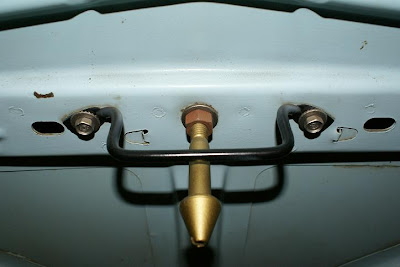Television---------------------------------C5AZ-18804-A----------$169.95
Deluxe 14" wheel cover w/spinner---------C6ZZ-1130-B-------------$33.20 (set of 4)
'Mag' wheel cover/14"---------------------C6OZ-1130-J-------------$81.15 (set of 4)
Styled steel wheel-------------------------C5ZZ-1007-B(wheel)------$158.40(set of 4)
Lug nuts----------------------------------C5ZZ-1012-A-------------$9.60(set of 20)
Center cap--------------------------------C5ZZ-1130-G-------------$10.00
Wire wheel cover-------------------------C5OZ-1130-C--------------$83.35(set of 4)
'White wall' trim rings 13"-----------------C5AZ-1211-A--------------$14.58(set of 4)
14"-----------------C5AZ-1211-B---------------"-------------"
15"-----------------C5AZ-1211-C---------------"-------------"
Floor mats/ front twin---------------------C5ZZ-6513086*-----------$7.95
/ Rear twin---------------------C5ZZ-6513106*------------$4.96
*= specify color
Full Tonneau Cover( cockpit cover)--------C5ZZ-76501A42-A(blk)---$52.70
"---------------------------------)--------C5ZZ-76501A42-B(wht)---$52.70
Door edge guards-------------------------C5ZZ-6520910-A----------$3.45
Rear seat armrest with ashtray-----------C5ZZ-6531600------------$15.20 pr (65)
"------------------------------"----------C6ZZ-6531600-------------$15.20 pr (66)
Air conditioner---------------------------C6ZZ-19700-A(6 cyl)-B(V8)-$240.00
Speed control----------------------------C6AZ-9A818-A--------------$71.40
Throttle control kit----------------------C4AZ-9B742-A--------------$10.00
Engine coolant heater------ 550 watt----C3RZ-8B152-A--------------$13.45
"--------------------------"1000 watt--C3RZ-8B152-B--------------$15.50
Both plug into household outlet
Power brakes----------------------------C62A091-A-----------------$47.00
Inside day/night mirror-----------------C6ZZ-17700-A--------------$4.95
Right-hand standard mirror------------C3RZ-17696-A---------------$2.45
Left-hand remote mirror---------------C5ZZ-17696-A---------------$12.95
Cigarette lighter/ map light------------C2RZ-15072-A---------------$3.00
Trunk light----------------------------C2RZ-15A700----------------$2.35
Parking brake warning light----------C4DZ-15A852-A---------------$3.80
Spot light----------------------------C5ZZ-15313-A(L.H.)-----------$29.95
"---------"--------------------------C5ZZ-15313-B(R.H.)------------$29.95
Turn signal-Fender mount----------C5AZ-13A310-A----------------$7.15 pr
Compass----------------------------C4RZ-19A548-A----------------$7.95
Trunk mount luggage rack----------C5ZZ-6555100-F---------------$39.95
Luggage rack hold-down straps-----C5ZZ-6555196-A---------------$5.25
Electric clock-----------------------C6ZZ-15A000-A----------------$20.80
Vinyl top--------------------------C5ZZ-6350005-A(blk)-B (wht)--$69.50
Stainless sill plate-----------------C5ZZ-6513242-A----------------$9.95 pr
Litter basket---------------------C1AZ-19D504-A thru D----------$2.45
Tissue dispenser------------------C3RZ-19A549-A----------------$3.95
Remote trunk release-------------C6AZ-65432A00-A------------$6.95
Adjustable clothes rod-----------C4AZ-19D536-A-----------------$3.00
Auto vacuum (plugs into lighter socket) C5AZ-19E521-A----------$14.95
Radiator bug screen-------------C5AZ-8198-A-------------------$1.95
Am/Fm radio-------------------C6ZZ-18805-BA----------------$123.15
CB radio------------------------C5AZ-18805-E------------------$179.50
Two-way walkie-talkie---------C5AZ-18805-F------------------$119.50
Studiosonic sound (reverb)-----C6AZ-18875-A------------------$27.95
Luggage rack zipper bag-------B9AZ-19B507-B-----------------$39.95
Rotunda child car seat---------C6AZ-19E535-A-----------------$29.95
Rotunda child safety vest------C6AZ-19F519-A-----------------$10.95
Child proof lock knobs--------C6AZ-5421850-A-----------------$2.95 pr
Reflector/ flare kit-----------C5AZ-19E500-A-------------------$11.20
Fire extinguisher/ 2 3/4 lb--C3RZ-19B540-A-------------------$16.50
"-----------------" 5 lb------C5AZ-19B540-A------------------$27.50
Dual air horns---------------C5AZ-13800-A-------------------$53.50
Glove box lock--------------C4DZ-6206081-A-----------------$2.50
Engine gauge kit------------C6AZ-10B944-B-------------------$45.00 ( A single round gauge housing with engine vacuum, water temp, oil pressure and volts. Not the rally-pac)
Cobra Tach------------------C5AZ-17A326-A (6K, V8) (-B 6k, 6 cyl) $42.50
Cobra tach------------------C5AZ-17A326-C ( 9K, V8)---------$46.50
Sun Tach-------------------C4AZ-17368-A (9K V8)-----------$60.00
Sun Tach mounting kit------C4AZ-17368-A-------------------$6.10
Seat belt retractors---------C4AZ-62611A06-A---------------$3.85 pr
I'll put some more of this stuff up later, when I type it up.


















































